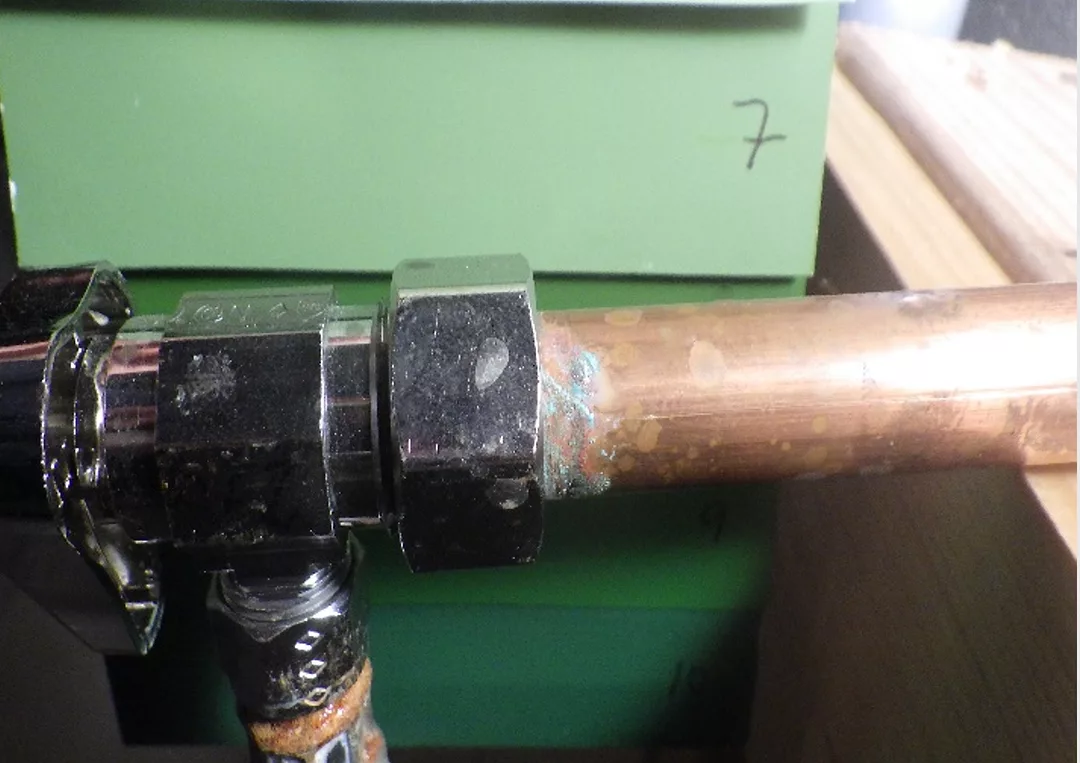The modern field of forensic engineering evaluates the origin, cause and duration of failed building components. As many failed components are subject to insurance claims and legal probes, a scientific methodology for evaluating such events is inherently valuable.
Commonly employed methods of engineering corrosion analysis prove impractical for an evaluation of a simple plumbing leak and ensuing damage. The results of this study provide a scientific methodology to evaluate the time frame of low-volume compression-fitting leaks by quantifying the extent and color depth of corrosion and patina.
Multiple, common angle stop valves and flexible supply lines with compression fittings were placed in a linear configuration along a common incoming pipe. Leaks were generated from the upper supply line nut and the angle stop compression nut (see Figure 1). A control sample was subjected to the same conditions without leaks to separate normal weathering from direct leak exposure.
Over the 16-week study, specimens were analyzed for corrosion and patina. Observed corrosion and patina were rated on a 1 through 10 color scale, with higher numbers corresponding to deepening shades of orange and green, respectively.
Corrosion and patina were observed to be progressive, surrounding the wetted components, as hypothesized. Data was plotted against time to visually observe the trend (see Figure 2). The resulting trendline equation represents a prescriptive method for analyzing the time frame of future leaks based on color depth analysis.
The color depth and extent of corrosion and patina are accurate indicators of the length of time of moisture exposure as colors progressively deepened upon extended water exposure.
Low-volume supply leaks are self-sealing over time. All the leaks consistently diminished with time and some of the drips spontaneously sealed completely. Suspended solid particles within the water progressively lodged in the thread spaces and sealed the low-volume drips. Secondly, thermal expansion and contraction of metal supply components likely played a role in spontaneously sealing the leaks, as metals expanded and contracted with daily and seasonal thermal cycles.
Corrosion first occurred and the most severe corrosion was noted on the supply line at the factory-crimped connection below the upper nut (see Figure 4). The surface was in direct contact with descending water from drips. Consequently, the logical conclusion is that wetted steel surfaces from plumbing leaks contained the most inherent potential risk to exhibit corrosion.
Patina occurred as faint spots over the surface of the pipe and not to the portion of the pipe that was in direct contact with water. Ambient moisture or humidity caused the patina spots, as evidenced by the control sample which was not directly exposed to water and similarly exhibited patina spots.
Minute accumulated patina was physically observed on the copper pipe directly below the drip location. When measured to the tenth of a millimeter, no appreciable built-up patina or accumulated deposits were able to be quantified, which led to the conclusion that extremely long periods of time are required for the accumulated patina to occur (see Figure 4).




